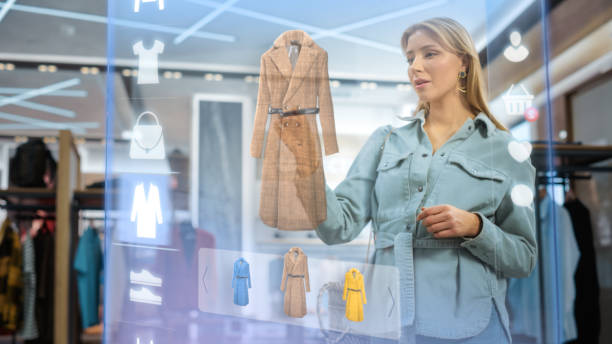Augmented Reality in Luxury Fashion Retail: A Guide
Luxury fashion retailers are embracing augmented reality to offer customers an immersive and interactive shopping experience. This guide explores how AR technologies are being used to elevate brand storytelling, streamline product discovery, and transform in-store engagement. Readers will learn how virtual try-ons, 3D product displays, and personalized features are shaping the future of luxury shopping—balancing innovation with elegance.

How Luxury Brands Are Using AR to Enhance Shopper Interaction
Luxury fashion houses have implemented AR technology to create more engaging and interactive shopping experiences. Brands like Gucci, Burberry, and Louis Vuitton have developed AR applications that allow customers to visualize products in their personal space or on themselves before making purchase decisions.
These implementations include AR mirrors in fitting rooms that suggest complementary items, smartphone apps that overlay digital fashion pieces onto real-world environments, and interactive displays that respond to customer movements. The technology enables brands to provide detailed product information, styling suggestions, and exclusive content that enhances the traditional shopping journey.
Virtual Try-On Experiences in High-End Retail
Virtual try-on technology has revolutionized how customers experience luxury fashion products. Through AR-enabled devices, shoppers can see how clothing items, jewelry, watches, and cosmetics look on them without physical contact with the products.
High-end retailers have installed AR mirrors and tablets that use advanced camera systems and machine learning algorithms to accurately map digital products onto customers’ bodies. This technology accounts for lighting conditions, body proportions, and fabric draping to provide realistic representations. The virtual try-on experience extends beyond physical stores through mobile applications that customers can use from home, expanding the reach of luxury retail experiences.
Benefits of AR for Storytelling and Brand Immersion
AR technology enables luxury brands to create compelling narratives around their collections and heritage. Customers can access historical information about craftsmanship, view behind-the-scenes content from fashion shows, and explore the inspiration behind specific designs through interactive AR experiences.
Brand immersion occurs through AR installations that transport customers to different environments related to the brand’s story. Fashion houses use this technology to showcase their manufacturing processes, highlight sustainable practices, and demonstrate the quality of materials used in their products. These immersive experiences strengthen emotional connections between customers and brands while providing educational content about luxury fashion creation.
Future Trends in AR Technology for Fashion Boutiques
The evolution of AR technology promises more sophisticated applications in luxury fashion retail. Emerging trends include artificial intelligence integration that personalizes AR experiences based on customer preferences and purchase history. Advanced haptic feedback systems will allow customers to feel fabric textures and garment weights through AR interfaces.
Spatial computing developments will enable more precise virtual fitting experiences with improved accuracy in size recommendations. Integration with social media platforms will allow customers to share virtual try-on experiences and receive feedback from their networks. Additionally, AR technology will likely incorporate biometric data to suggest products based on skin tone analysis and body measurements.
The Role of AR in Customer Loyalty and Engagement
AR technology contributes significantly to building customer loyalty in luxury fashion retail by creating memorable and personalized experiences. Customers who engage with AR features demonstrate higher levels of brand attachment and increased likelihood of repeat purchases.
Luxury retailers use AR to gamify the shopping experience through exclusive virtual collections, limited-time AR experiences, and loyalty program integrations. These initiatives encourage customers to visit stores more frequently and engage with brands across multiple touchpoints. The technology also enables brands to collect valuable data about customer preferences and behaviors, facilitating more targeted marketing efforts and product development strategies.
| AR Solution Type | Provider Examples | Implementation Cost Range | Key Features |
|---|---|---|---|
| Virtual Try-On Mirrors | ModiFace, Perfect Corp | $15,000 - $50,000 | Real-time fitting, product recommendations |
| Mobile AR Apps | ARitize3D, Zakeke | $25,000 - $100,000 | Home try-on, social sharing, analytics |
| Interactive Displays | Holition, Marxent | $30,000 - $80,000 | Product visualization, brand storytelling |
| AR Shopping Platforms | Snap Camera Kit, 8th Wall | $20,000 - $75,000 | Cross-platform compatibility, cloud processing |
Prices, rates, or cost estimates mentioned in this article are based on the latest available information but may change over time. Independent research is advised before making financial decisions.
The integration of augmented reality in luxury fashion retail represents a significant shift toward technology-enhanced customer experiences. As AR capabilities continue to advance, luxury brands will likely develop even more sophisticated applications that blur the lines between digital and physical retail environments. The success of AR implementation depends on seamless integration with existing retail operations and careful attention to maintaining the exclusivity and personal service that define luxury fashion shopping experiences.




